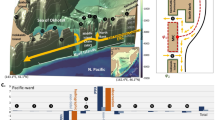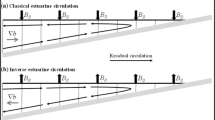Abstract
The sudden intrusion of Kuroshio warm water into the Bungo Channel (kyucho) occurs mainly at neap tides during summer, suggesting that tidal mixing is one of the essential factors regulating kyucho. In order to clarify the physical mechanisms responsible for the regulation of kyucho, we carry out non-hydrostatic three-dimensional numerical experiments allowing Kuroshio warm water to intrude into a strong tidal mixing region. It is shown that the Kuroshio warm water can (or cannot) pass through the tidal mixing regions off the east coast of the Bungo Channel during neap (or spring) tides. The analysis of the dynamic balance off the east coast of the Bungo Channel shows that tidal residual currents generated by tidal flow interaction with complicated land configurations off the east coast of the Bungo Channel can also play an important role in regulating kyucho. In order to assess separately the effects of tidal mixing and tidal residual currents on kyucho, we incorporate the parameterized vertical mixing and tidal stresses into the numerical model instead of tidal currents. It is demonstrated that tidal mixing cannot by itself block the northward intrusion of Kuroshio warm water, and that an additional effect induced by tidal residual eddies equivalent to horizontal mixing is needed to regulate kyucho. This strongly suggests that the basin–ocean water exchange processes in areas with complicated land configurations can only be reproduced by taking into account the effects of tidal residual eddies on a 1-km scale in addition to tidal mixing effects evaluated by microstructure measurements.







Similar content being viewed by others
References
Arai M (2005) Numerical study of a kyucho and a bottom intrusion in the Bungo Channel, Japan: Disturbances generated by the Kuroshio small meanders. J. Oceanogr 61:953–971
Awaji T, Imasato N, Kunishi H (1980) Tidal exchange through a strait; A numerical experiment using a simple model basin. J Phys Oceanogr 10:1499–1508
Drinkwater KF, Loder JW (2001) Near-surface horizontal convergence and dispersion near the tidal-mixing front on Northeastern Georges Bank. Deep-Sea Res Part II 48:311–339
Griffin DA, LeBlond PH (1990) Estuary/ocean exchange controlled by spring-neap tidal mixing. Estuar Coast Shelf Sci 30:275–297
Hibiya T, LeBlond PH (1993) The control of fjord circulation by fortnightly modulation of tidal mixing processes. J Phys Oceanogr 23:2042–2052
Isobe A, Guo X, Takeoka H (2010) Hindcast and predictability of sporadic Kuroshio-water intrusion (kyucho in the Bungo Channel) into the shelf and coastal waters. J Geophys Res 115. doi:10.1029/2009JC005818
Linden PF, Simpson JE (1986) Gravity-driven flows in a turbulent fluid. J Fluid Mech 172:481–497
Linden PF, Simpson JE (1988) Modulated mixing and frontogenesis in shallow seas and estuaries. Cont Shelf Res 8:1107–1127
Marshall J, Adcroft A, Hill C, Perelman L, Heisey C (1997) A finite-volume, incompressible Navier Stokes model for studies of the ocean on parallel computers. J Geophys Res 102:5753–5766
Miyazawa Y, Kagimoto T, Guo X, Sakuma H (2008) The Kuroshio large meander formation in 2004 analyzed by an eddy-resolving ocean forecast system. J Geophys Res 113. doi:10.1029/2007JC004226
Miyazawa Y, Zhang R, Guo X, Tamura H, Ambe D, Lee JS, Okuno A, Yoshinari H, Setou T, Komatsu K (2009) Water mass variability in the western North Pacific detected in a 15-year eddy resolving ocean reanalysis. J Oceanogr 65:737–756
Nagai T, Hibiya T (2011) The processes of semi-enclosed basin-ocean water exchange across a tidal mixing zone. J Oceanogr 67:533–539
Nagai T, Hibiya T (2012) Numerical simulation of tidally induced eddies in the Bungo Channel: A possible role for sporadic Kuroshio-water intrusion (kyucho). J Oceanogr 68:797–806
Oonishi Y (1977) A numerical study on the tidal residual flow. J Oceanogr 33:207–218
Oonishi Y, Kunishi H (1979) Water exchange between adjacent vortices under an additional oscillatory flow. J Oceanogr 35:136–140
Ott MW, Dewey R, Garrett C (2002) Reynolds stresses and secondary circulation in a stratified rotating shear flow. J Phys Oceanogr 32:3249–3268
Sentchev A, Korotenko K (2005) Dispersion processes and transport pattern in the ROFI system of the eastern English Channel derived from a particle-tracking model. Cont Shelf Res 25:2294–2308
Signell RP, Geyer WR (1990) Numerical simulation of tidal dispersion around a coastal headland. Coast Estuar Studies 38:210–222
Takeoka H (2002) Progress in Seto Inland Sea research. J Oceanogr 58:93–107
Takeoka H, Yoshimura T (1988) The Kyucho in Uwajima Bay. J Oceanogr 44: 6–16
Takeoka H, Akiyama H, Kikuchi T (1993) The Kyucho in the Bungo Channel, Japan—periodic intrusion of oceanic warm water. J Oceanogr 49:369–382
Zimmerman JTF (1981) Dynamics, diffusion and geomorphological significance of tidal residual eddies. Nature 290:549–555
Acknowledgments
The authors would like to express their gratitude to Prof. H. Takeoka, Prof. X. Guo and Dr. E. Tsutsumi of the Center for Marine Environmental Studies (CMES) of Ehime University and Prof. T. Matsuno of the Research Institute for Applied Mechanics (RIAM) of Kyushu University for their thoughtful arrangement of the field observations in the Bungo Channel. Thanks are extended to the captain of R/V “Isana” of CMES of Ehime University and the scientific parties on board for their help in collecting the data.
Author information
Authors and Affiliations
Corresponding author
Appendix
Appendix
1.1 Tidal residual eddies and associated horizontal eddy diffusivity in the Bungo Channel
Figure 8 shows depth- and tidally averaged relative vorticity and barotropic tidal currents, namely, tidal residual currents, obtained from additional numerical experiments in which Kuroshio warm water is not forced at the southern boundary. We can see that strong tidal residual eddies exceeding 0.3 m s−1 with a diameter of a few kilometers are generated off the east coast of the Bungo Channel during spring tides, although they nearly vanish during neap tides. Tidal residual eddies are thought to play an important role in transporting materials in the coastal ocean (Oonishi and Kunishi 1979; Awaji et al. 1980; Zimmerman 1981). It is interesting to note that such small tidal residual eddies are hardly reproduced by low-resolution (∆x = ∆y = 1/100°) numerical models (Fig. 8c). Although the horizontal grid resolution of 1/100° is thought to be, in general, fine enough to model coastal phenomena, it is already too coarse to adequately resolve small residual eddies induced by tidal flow interaction with complicated land configurations.
To quantify the effective horizontal diffusivity associated with tidal residual eddies, we now solve a horizontally two-dimensional advection equation for a passive tracer C given by
where \( {\mathbf{U}}_{\text{bt}} \) is the barotropic tidal velocity, and \( \nabla_{H} = (\partial /\partial x,\partial /\partial y) \) is the horizontal gradient operator. Initially, the passive tracers C1 and C2 with concentration of 1 are placed inside and outside the archipelago area off the east coast of the Bungo Channel, respectively (red box in Fig. 9), and are allowed to spread out in the barotropic tidal velocity field during spring tides obtained from Ex:KYC. As a measure of the spreading of tracer in the oscillatory flow, we define the horizontal eddy diffusivity (K He),
with
(Signell and Geyer 1990; Drinkwater and Loder 2001; Sentchev and Korotenko 2005) where T M2 and σ indicate the M2 tidal period and the standard deviation of the tracer location relative to the center of mass (x 0, y 0) at time t, respectively.
Figure 9 shows the distribution of each passive tracer after 3T M2 from the start of calculation, where C2 is advected towards the center of the Bungo Channel without noticeable dispersion, whereas C1 spreads out over a large area while being diluted. Figure 10 shows the time variation of K He for \( T_{{{\text{M}}2}} \le t \le 3T_{{{\text{M}}2 }} \), where the horizontal eddy diffusivity off the east coast of the Bungo Channel (C1) is found to reach K He ∼ 102 m2 s−1, more than ten times that obtained outside the archipelago area (C2, K He < 101 m2 s−1). These results clearly indicate that tidal residual eddies generated behind complicated land configurations play a crucial role in the horizontal dispersion processes.
Rights and permissions
About this article
Cite this article
Nagai, T., Hibiya, T. Effects of tidally induced eddies on sporadic Kuroshio-water intrusion (kyucho). J Oceanogr 69, 369–377 (2013). https://doi.org/10.1007/s10872-013-0179-3
Received:
Revised:
Accepted:
Published:
Issue Date:
DOI: https://doi.org/10.1007/s10872-013-0179-3







